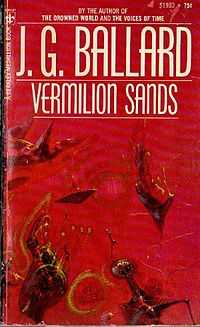Vermilion Sands
| Vermilion Sands | |
|---|---|
 1st edition | |
| Author | J. G. Ballard |
| Cover artist | Richard Powers |
| Country | United Kingdom |
| Language | English |
| Genre | Science fiction |
| Publisher | Berkley Books |
Publication date | 1971 |
| Pages | 192 |
| ISBN | 0-425-01980-2 |
Vermilion Sands is a short-story collection by J. G. Ballard, first published in 1971. All the stories are set in an imaginary vacation resort called Vermilion Sands which suggests, among other places, Palm Springs in southern California. The characters are generally the wealthy and disaffected, or people who make a living off them, and parasites of various kinds.
In the preface, Ballard himself wrote: "Vermilion Sands has more than its full share of dreams and illusions, fears and fantasies, but the frame for them is less confining. I like to think, too, that it celebrates the neglected virtues of the glossy, lurid and bizarre."
The collection
Stories
Vermilion Sands contains the following stories:
- "Prima Belladonna" (1956)
- "The Thousand Dreams of Stellavista" (1962)
- "Cry Hope, Cry Fury!" (1966)
- "Venus Smiles" (1957)
- "Studio 5, The Stars" (1961)
- "The Cloud-Sculptors of Coral D" (1967)
- "Say Goodbye to the Wind" (1970)
- "The Screen Game" (1962)
- "The Singing Statues" (1962)
Exotic technology
Each story concentrates on different media - in some cases more than one - and most of them focus on a particular innovative, usually rather decadent/baroque twist on an existing artistic medium. For instance:
- "Prima Belladonna" focuses on music, especially singing, via singing plants and a 'mutant' voice;
- "The Thousand Dreams of Stellavista" focuses on architecture, via mobile, mood-sensitive houses;
- "Cry Hope, Cry Fury" focuses on painting, through paints that respond to the presence of light/objects (an example of decadence through the evaporation of skill);
- "Venus Smiles" focuses on sculpture, through the creation of a (strangely growing) sound sculpture;
- "Studio 5, The Stars" focuses on poetry, through automated poetry machines (another example of skill vanishing, this time into automation);
- "The Cloud-Sculptors of Coral D" focuses on a peculiar kind of sculpture made by carving clouds - painting also appears in this one;
- "Say Goodbye to the Wind" focuses on fashion via living fashion and sound jewelry (non-aural music and erotic food are also mentioned in passing);
- "The Screen Game" has no unusual technologies, but an unusual aesthetic - jewels and screens dominate;
- "The Singing Statues" returns to sound sculpture (which may have been why it was removed from the American Berkley Medallion edition of 1971).
Although the characters themselves often exhibit the same obsession, anomie and psychological disintegration typical of Ballard's characters, the emphasis on elaborate and sometimes humorously imagined art forms gives these stories a playfulness unusual in his other stories. A few other stories not set in Vermilion Sands are comparable because of their similar artistic games, especially "Sound-Sweep" (1960, on music/opera) and "Passport to Eternity" (1962, full of decadent trends and live fashions).
Popular culture references
- The song "Vermilion Sands" on the Buggles album Adventures In Modern Recording is probably referring to this collection.
- A 1980s Japanese progressive rock band was called "Vermilion Sands". Their album featured a song entitled "The cloud-sculptors of Coral D".[1]
- Vermilion Sands is the name taken by a garage-pop band from Treviso, Italy.
References
External links
- The Terminal Collection: JG Ballard First Editions
- Image of the Vermilion Sands resort assuming that it is located on Mars; Source: Pyracanthas Sketch Blog Spot:
- Website illustrating various covers used for the book Vermilion Sands and Ballard's comment comparing it in 1975 to current European Mediterranean resorts: